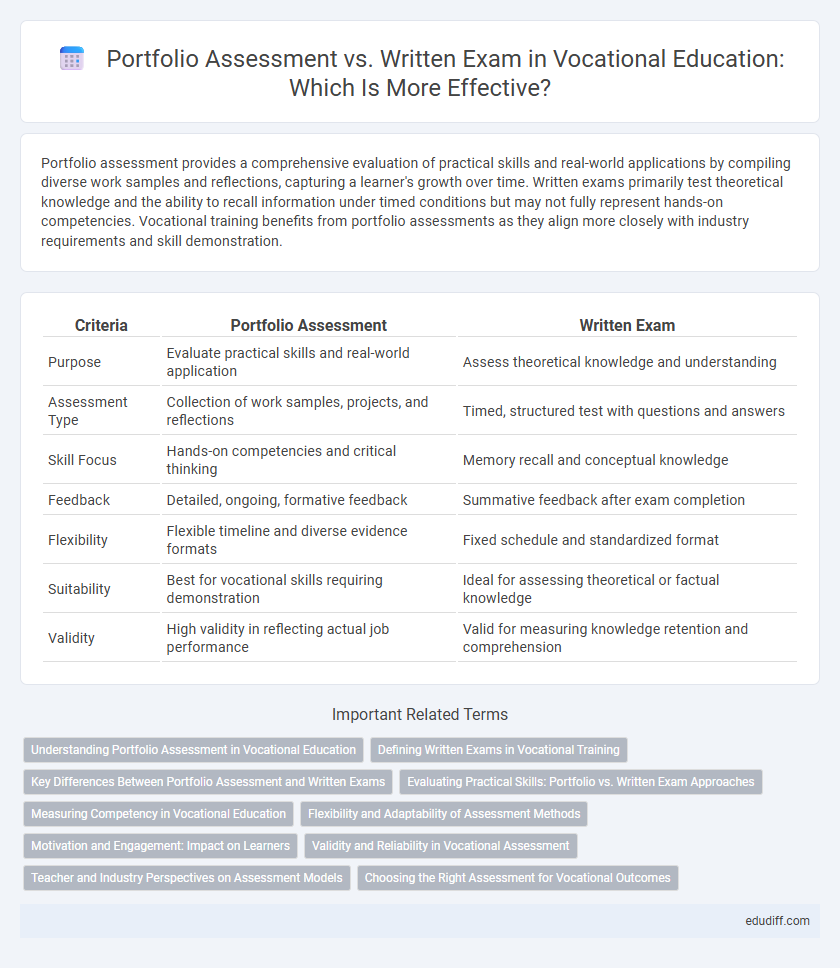Portfolio assessment provides a comprehensive evaluation of practical skills and real-world applications by compiling diverse work samples and reflections, capturing a learner's growth over time. Written exams primarily test theoretical knowledge and the ability to recall information under timed conditions but may not fully represent hands-on competencies. Vocational training benefits from portfolio assessments as they align more closely with industry requirements and skill demonstration.
Table of Comparison
| Criteria | Portfolio Assessment | Written Exam |
|---|---|---|
| Purpose | Evaluate practical skills and real-world application | Assess theoretical knowledge and understanding |
| Assessment Type | Collection of work samples, projects, and reflections | Timed, structured test with questions and answers |
| Skill Focus | Hands-on competencies and critical thinking | Memory recall and conceptual knowledge |
| Feedback | Detailed, ongoing, formative feedback | Summative feedback after exam completion |
| Flexibility | Flexible timeline and diverse evidence formats | Fixed schedule and standardized format |
| Suitability | Best for vocational skills requiring demonstration | Ideal for assessing theoretical or factual knowledge |
| Validity | High validity in reflecting actual job performance | Valid for measuring knowledge retention and comprehension |
Understanding Portfolio Assessment in Vocational Education
Portfolio assessment in vocational education evaluates a learner's practical skills and competencies through the compilation of real-world work samples, projects, and reflective entries, offering a comprehensive view of their abilities beyond theoretical knowledge. This method emphasizes continuous assessment and skill demonstration in authentic contexts, making it more aligned with vocational learning outcomes than traditional written exams. It supports personalized feedback and promotes critical self-reflection, facilitating deeper understanding and mastery of trade-specific tasks.
Defining Written Exams in Vocational Training
Written exams in vocational training are structured evaluations that measure theoretical knowledge and comprehension of specific job-related skills. These assessments typically consist of multiple-choice questions, short answers, or essays designed to test understanding of technical concepts and industry standards. Written exams serve as a standardized method to validate learners' mastery of foundational knowledge essential for skilled vocational performance.
Key Differences Between Portfolio Assessment and Written Exams
Portfolio assessment evaluates practical skills and real-world applications through a collection of student work, offering a comprehensive view of competency over time. Written exams test theoretical knowledge and problem-solving abilities under time constraints, providing a snapshot of understanding at a specific moment. Portfolio assessment emphasizes continuous learning and skill development, while written exams focus on memorization and immediate recall of information.
Evaluating Practical Skills: Portfolio vs. Written Exam Approaches
Portfolio assessment offers a comprehensive evaluation of practical skills by showcasing real-world projects, hands-on experiences, and reflective learning, providing a holistic view of a student's capabilities. Written exams primarily assess theoretical knowledge and problem-solving abilities but often lack insight into actual skill application and performance in vocational tasks. Combining portfolio assessments with written exams enhances the accuracy of evaluating vocational competence, ensuring both practical expertise and conceptual understanding are measured effectively.
Measuring Competency in Vocational Education
Portfolio assessment provides a comprehensive evaluation of a learner's practical skills, continuous progress, and real-world application in vocational education, capturing competencies beyond theoretical knowledge. Written exams primarily measure theoretical understanding and cognitive recall, offering limited insight into hands-on abilities or problem-solving skills essential for vocational mastery. Effective competency measurement in vocational training requires integrating both methods to balance practical proficiency with foundational knowledge.
Flexibility and Adaptability of Assessment Methods
Portfolio assessment offers greater flexibility and adaptability by allowing learners to demonstrate skills through diverse, real-world projects and reflections tailored to individual learning paths. Unlike rigid written exams, portfolios accommodate varied learning styles and provide a comprehensive evaluation of practical competencies in vocational education. This dynamic approach supports continuous growth and better aligns assessment with industry demands for versatile skill sets.
Motivation and Engagement: Impact on Learners
Portfolio assessment enhances learner motivation by allowing students to demonstrate skills through real-world projects, fostering deeper engagement and intrinsic interest. Written exams often trigger anxiety and may not fully capture practical competencies, leading to decreased motivation. Authentic assessment methods like portfolios support sustained learner investment by connecting evaluations to meaningful vocational experiences.
Validity and Reliability in Vocational Assessment
Portfolio assessments in vocational education offer higher validity by showcasing real-world skills and ongoing competence through diverse evidence, while written exams often lack this practical relevance. Reliability in written exams is generally stronger due to standardized questions and scoring, whereas portfolios may face variability in evaluator judgment and consistency. Combining both methods can enhance overall assessment accuracy by balancing practical demonstration and objective measurement.
Teacher and Industry Perspectives on Assessment Models
Teachers emphasize portfolio assessments for vocational training as they provide a comprehensive view of a student's practical skills, problem-solving abilities, and real-world application, which aligns closely with industry demands for job-ready graduates. Industry professionals value portfolio assessments because they showcase tangible work samples, adaptability, and continuous learning, offering deeper insights into a candidate's competency beyond theoretical knowledge tested in written exams. While written exams assess foundational knowledge and standardize evaluation, portfolios bridge the gap between academic learning and workplace expectations, making them a preferred model for vocational assessment in teacher and industry collaborations.
Choosing the Right Assessment for Vocational Outcomes
Portfolio assessment provides a comprehensive evaluation of practical skills and real-world competencies essential for vocational success, whereas written exams primarily test theoretical knowledge and cognitive understanding. Choosing the right assessment method depends on aligning evaluation criteria with vocational goals, emphasizing hands-on performance and applied learning outcomes. Integrating portfolio assessments enhances the authenticity of skill validation, supporting effective workforce readiness in diverse vocational fields.
Portfolio Assessment vs Written Exam Infographic

 edudiff.com
edudiff.com